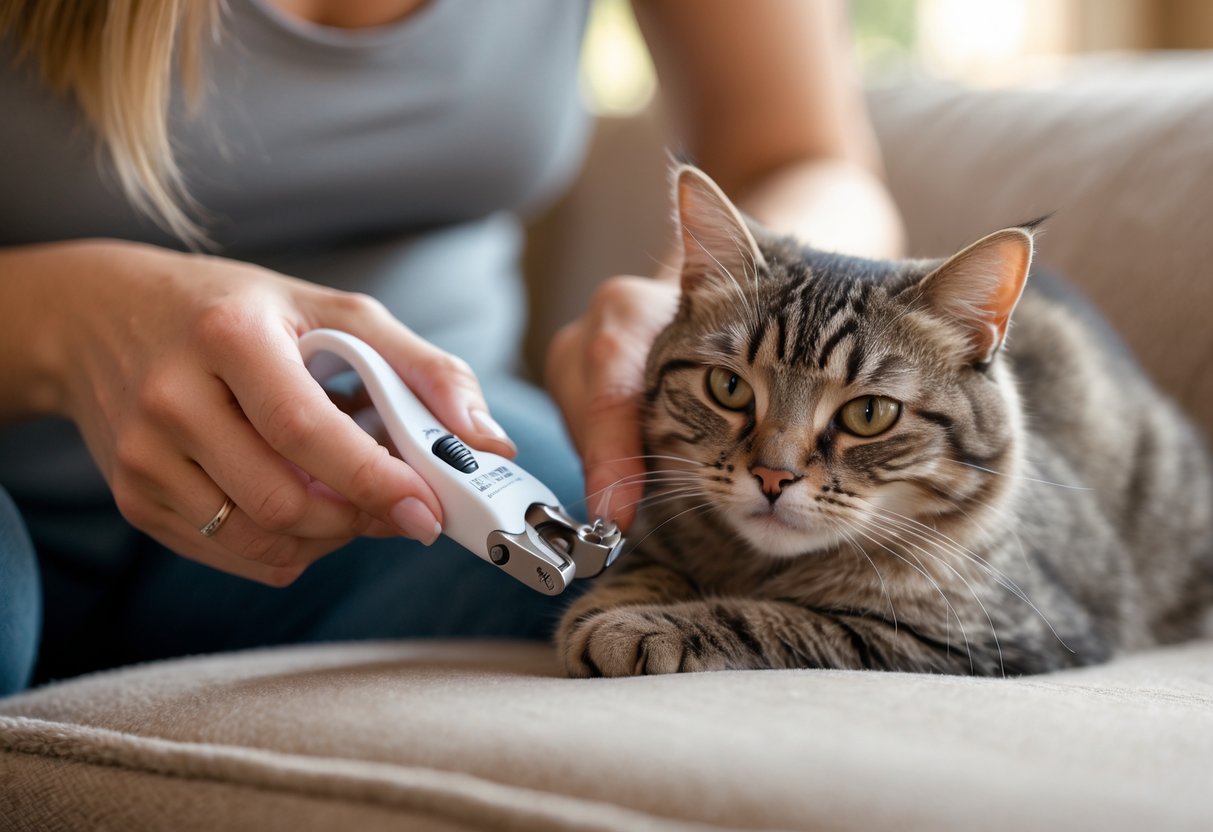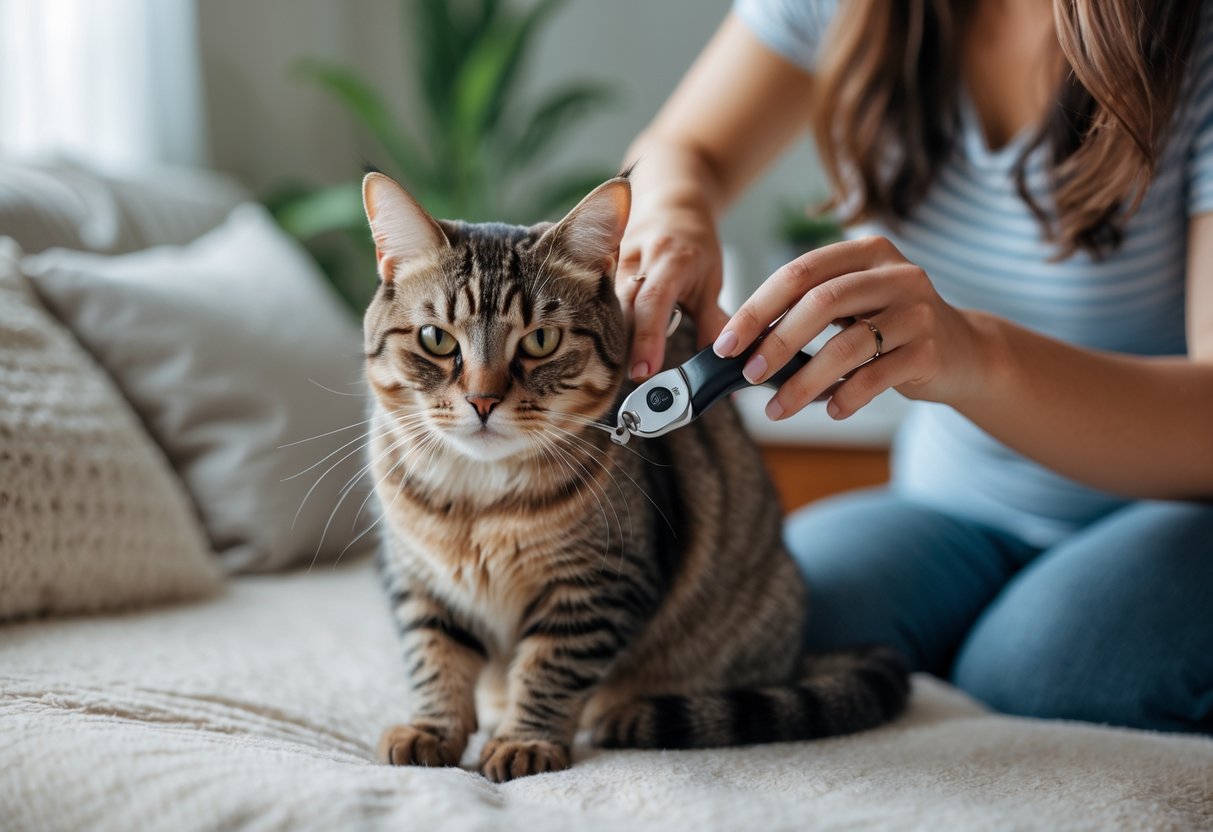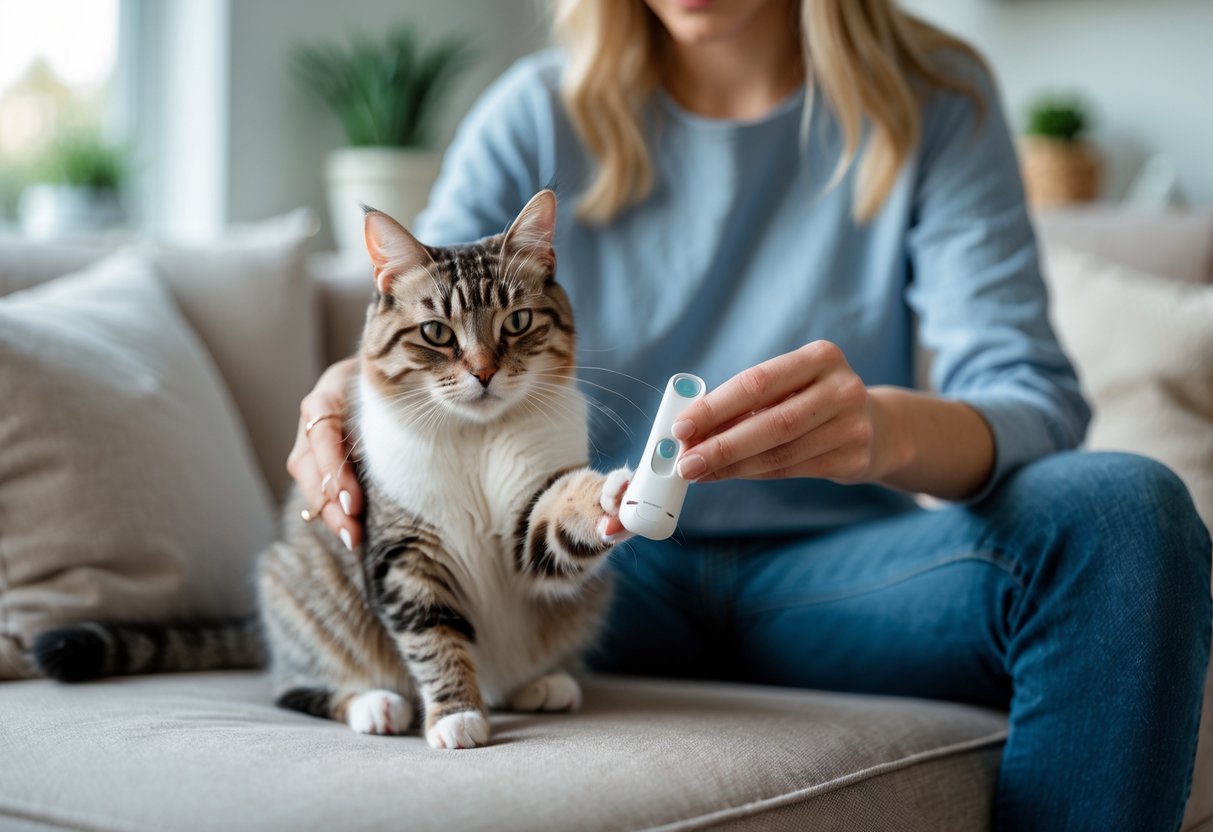Physical Address
304 North Cardinal St.
Dorchester Center, MA 02124
Physical Address
304 North Cardinal St.
Dorchester Center, MA 02124

Trimming a cat’s nails at home can sound stressful, but it helps keep both the cat and the household safer and healthier. Most cats need regular nail trims to prevent their claws from getting too long, catching on things, or causing accidental scratches. Many cat owners find that learning how to do this themselves makes the process convenient and less stressful for their pets.

With the right tools and a step-by-step approach, anyone can safely trim their cat’s nails without having to visit a groomer or vet every time. This guide will cover easy techniques, practical tips, and how to solve common issues, making at-home nail care simple and manageable.

Trimming a cat’s nails can help prevent pain, injury, and damage to the home. Regular care supports a cat’s well-being and keeps both pets and people safe during play and daily activities.
Regularly trimmed nails reduce the chance of painful breaks or splits in cat claws. This helps cats move comfortably and lowers the risk of ingrown nails, which can cause infections.
Short nails are less likely to scratch floors, furniture, or people. Cats with properly trimmed claws are easier to handle during play or grooming. Keeping claws neat also limits accidental injuries to other pets in the home.
Routine trimming can make cats more comfortable indoors by preventing snagging on carpets or bedding. Caring for cat claws builds trust and helps cats feel comfortable with being handled, especially if started at a young age.
If a cat’s nails get too long, they can curl under and grow into the paw pads. This condition can be very painful and may require a trip to the veterinarian. Overgrown cat claws are more likely to get caught in fabric or furniture, causing injury.
Long nails can lead to scratches on people, other pets, and household items. Cats who do not have their claws trimmed have a greater risk of broken or splintered nails, which are uncomfortable and can cause infections.
Untended claws increase the likelihood of the cat’s nails becoming sharp and hooked, making grooming and vet visits harder. In older or less active cats, the risk is higher because they use their claws less to wear them down naturally.
Indoor cats often need their nails trimmed more often because they do not have access to rough surfaces like trees to wear their claws down naturally. They use scratching posts, but these may not keep nails short enough.
Outdoor cats usually take care of their own claws by climbing, digging, and scratching on rough objects. However, they should still be checked for overgrown or damaged nails, especially older cats or those with health issues.
For both indoor and outdoor cats, regular inspection of the cat claws is important. Nail trimming should be part of a routine grooming schedule to ensure the cat’s comfort and reduce the chance of injury.

Proper preparation can help make nail trims safer and less stressful for both the cat and the person trimming the nails. Using the right tools, getting the cat comfortable with nail clippers, and helping the cat accept paw handling are all crucial steps.
Choosing the correct nail clippers is the first step for a successful trim. There are several varieties designed for cat claws, such as scissor-style clippers, guillotine-style clippers, and human nail clippers.
Scissor-style clippers often provide better control, making it easier to trim small, curved cat claws. Guillotine-style clippers have a hole for the claw and a blade that closes, but some find them harder to use on tiny nails. Human nail clippers may work for kittens or very small cats, but generally, clippers made for pets are safer and more effective.
Look for clippers with sharp, stainless steel blades. Dull clippers can cause splintering or crush the nail. Comfort grip handles help reduce hand fatigue during the process. Clean clippers before use to prevent spreading germs or bacteria to your cat.
It’s helpful to start letting the cat see and sniff the clippers before attempting a trim. Leave the clippers out where the cat spends time, so they become familiar objects. Letting a cat investigate the clippers reduces fear and builds trust.
Owners can try gently tapping the clippers around the cat when giving treats or petting sessions. This creates a positive association. Never rush this stage; some cats may need several days.
Short daily sessions, where the clippers are simply set near the cat, can help lower anxiety. If a cat shows fear or stress, pause and try again later. Make the experience predictable and calm by keeping a soft voice and using gentle movements.
Most cats do not like having their paws touched. Desensitization is best done in small, regular steps. Start by gently petting the cat’s legs and then touch or hold the paws while offering a treat.
Practice this for a few seconds at a time, gradually increasing the duration as the cat gets comfortable. Gently massage each paw pad and extend the claws without squeezing. Positive reinforcement, like praise or a favorite snack, encourages cooperation.
If the cat pulls away, avoid holding tight or forcing the paw. Try again later. Over time, the cat should become used to gentle paw handling, making actual nail trims much easier and less stressful for both parties.

Trimming a cat’s nails helps protect furniture and lowers the chance of scratches. By following key steps, owners can make nail trimming peaceful and safe for both themselves and their pets.
A calm setting is important when trimming a cat’s claws. Cats often react to loud noises and sudden movements, so the process should take place in a quiet room with little distraction. Soft lighting can help the cat feel less nervous.
A blanket or towel can provide comfort and security. Some owners play soft music or use treats to help their cat relax before starting. Allowing the cat to sniff and inspect the nail clippers ahead of time helps reduce fear.
Regular handling of the cat’s paws during playtime also builds trust. This gentle approach sets up a smoother nail trimming session.
Proper handling ensures the cat and the person trimming the nails stay safe. Support the cat’s body with one hand and hold its paw gently but firmly with the other.
Small cats may be placed on a lap or stable table. Wrapping the cat in a towel, leaving one paw exposed, can stop sudden movements and scratching. This is called the “kitty burrito” method.
Have all tools, including cat nail clippers, within reach so you do not leave the cat unattended. Praise and small treats after each trimmed nail can help the cat associate the process with a positive outcome.
Each cat nail has a pink area called the “quick.” This part contains nerves and blood vessels and must not be cut. Trimming too close can cause bleeding and pain.
The safe spot to cut is the clear, curved part of the claw, usually about 2 mm in front of the quick. Good lighting helps make the quick easier to see. Use sharp, clean cat nail clippers for best results.
If in doubt, trim a small amount rather than risk hurting the cat. Keep styptic powder nearby in case the quick is accidentally cut. This powder stops bleeding quickly and calmly.
Using the right tools and methods makes trimming a cat’s nails safer and easier. Gentle handling, correct clipping motion, and knowing when to reward the cat can reduce stress and prevent injury.
Cat nail clippers come in several styles, including scissor-type, guillotine-style, and human nail clippers. The most commonly recommended are small, scissor-style clippers made for cats. These allow for better control and accuracy.
Before trimming, check that the clippers are sharp and clean. Dull blades may crush the nail instead of cutting it. Always position the clippers perpendicular to the nail for a clean cut.
Hold the cat’s paw gently, press to extend the claw, and trim only the sharp, curved tip—avoid the pink “quick,” where nerves and blood vessels are. Cutting the quick is painful and may cause bleeding. If unsure, trim a tiny bit and move slowly.
Tip: Wipe the clippers with alcohol before and after use to keep them clean and safe.
Some cats become stressed by traditional clippers. In these cases, alternatives may help. Nail grinders (small rotary tools) gently file the nail, which can be less scary for some pets but takes longer and can be noisy.
Owners can try using human nail files or emery boards for gradual smoothing between full trims. Scratching posts and pads also help naturally wear down nails, although they do not replace trimming.
When traditional clipping fails, seek help from a veterinarian or professional groomer. They can use special restraint techniques and have experience in calming nervous cats.
Table: Common Tools for Cat Nail Care
| Tool | Best For |
|---|---|
| Scissor Clippers | Most cats, precision cutting |
| Guillotine Clippers | Small nails, experienced users |
| Nail Grinder | Sensitive or anxious cats |
| Emery Board/File | Minor touch-ups |
It’s important to watch the cat’s body language during a nail trim. If it pulls away, growls, or becomes tense, pause to reduce stress. Trimming just a few nails per session is fine; there’s no need to finish all at once.
After each paw or at the end of the session, give a treat or gentle praise. This positive reinforcement helps the cat associate nail trims with good experiences.
Breaks are helpful if the cat seems too restless. Some cats will only allow one or two nails at a time. Consistency and patience build trust over time, making future trims easier.
Cats often dislike nail trims, which can lead to stress for both the cat and the owner. Knowing how to manage fear, handle injuries, and deal with stubborn cats makes the process smoother and safer.
Many cats become anxious or scared during nail trims. Signs of stress include hiding, running away, or vocalizing. Slow, gentle handling helps reduce fear.
Start by letting the cat get used to the nail trimmer. Place the trimmers near the cat or let them sniff it. Offer treats before and after short handling sessions to create a positive connection.
Routine helps cats feel safe. Try to trim nails at the same time and place. Keep sessions short, especially when starting out. Speaking softly and stroking the cat during the process encourages calm behavior.
If a cat struggles, stop and try again later. For very scared cats, wrapping them in a towel with only one paw exposed can reduce movement and help them feel secure. Consistency and patience are key.
Sometimes, cutting a nail too short results in bleeding. This usually happens when the quick, the sensitive part inside the nail, is accidentally clipped.
Stay calm. If bleeding occurs, apply styptic powder or cornstarch to the tip of the nail. Press gently until the bleeding stops. Always have these supplies on hand before starting a trim.
Common Supplies for Bleeding Management:
| Item | Purpose |
|---|---|
| Styptic powder | Stops minor bleeding |
| Cornstarch | Alternative option |
| Clean cloth | Apply pressure |
Do not panic or scold the cat. Instead, offer comfort and wait a few minutes before continuing or stopping for the day. Watch for signs of infection, such as swelling or redness, in the days that follow.
When a cat refuses to sit still, special strategies can help. A second person can safely hold the cat while the other trims the nails. Wrapping the cat’s body gently in a towel creates a “kitty burrito” that limits movement while leaving one paw free.
Break the task into smaller steps. Trim just one or two nails per session if needed. Use high-value treats or favorite toys as rewards, associating nail trims with positive outcomes.
Some cats respond well to distraction, like gentle petting or the sound of a treat bag. For highly resistant cats, contact a veterinarian or a professional groomer for help. Safety is the main goal—never force the trim if the cat is highly aggressive or fearful.
Keeping a cat’s claws healthy is important for both their well-being and comfort. Routine maintenance and positive habits can help prevent painful issues such as ingrown nails or brittle claws.
Indoor cats usually need their claws trimmed every 2–4 weeks. More active cats may need less frequent trims if they wear their claws down naturally, while older or less active cats may need more attention. Watch for signs like claws snagging on fabrics or clicking on hard floors, which indicate it’s time for a trim.
Front paws tend to require more frequent trimming than back paws. Senior cats, especially those with arthritis, might develop thicker or overgrown nails which need regular checking. Consistently trimming claws helps avoid painful ingrown nails and lowers the chance of accidental scratches to both people and other pets.
Keep a log or set calendar reminders to stay on schedule. Early and regular trimming also helps cats remain more comfortable with the process.
Enrichment activities are key to supporting healthy cat claws between trims. Scratching posts, cardboard pads, and sisal mats allow cats to naturally shed the outer layer of their claws and keep them smooth. Place several types of scratchers in different areas to encourage frequent use.
Materials like sisal rope or corrugated cardboard are preferred by many cats because they create a satisfying texture. Providing toys that stimulate hunting and play—such as feather wands or balls—also encourages movement that helps wear claws down naturally.
Rotate scratchers and toys to keep them interesting. For added enrichment, sprinkle a bit of catnip on scratchers to attract interest. Regular play sessions keep cats active, reduce stress, and contribute to healthier claws overall.
Safe and effective cat nail trimming needs the right technique and tools. Understanding how often to trim, professional options, and alternatives to clipping can make the process less stressful for owners and their cats.
Start by gently holding the cat’s paw and pressing to extend the claws. Identify the clear, hooked tip and avoid the pink area, called the quick. Snip only the sharp tip using cat-specific trimmers. Work slowly, and offer breaks if the cat is anxious.
Most veterinarians offer nail trimming as part of routine care. Many pet grooming salons also offer this service. Check with local pet stores, animal clinics, or mobile pet groomers for options.
The best nail clippers for cats are small, scissor-style trimmers or guillotine-style clippers designed for pets. These provide better control and reduce the risk of splitting the nail. Avoid large or heavy clippers made for dogs.
Soft nail caps can be glued over a cat’s claws to prevent scratching. Regular use of scratching posts may also help keep nails worn down. Declawing is not recommended due to health risks and pain.
Most cats need their nails trimmed every 2 to 4 weeks. Indoor cats may need trims more often than outdoor cats. Watch for claws getting caught in fabrics, which can signal that trimming is needed.
Human nail clippers can be used on cats, but only if they are clean and sharp. They may not provide the same control as pet-specific clippers, so use them carefully and avoid cutting into the quick.